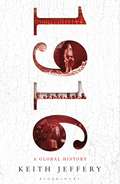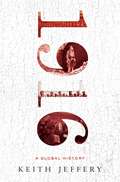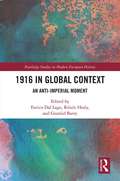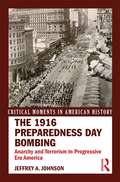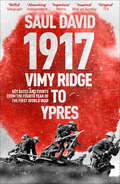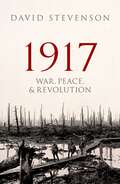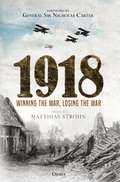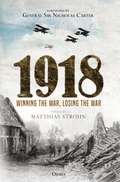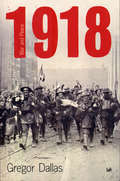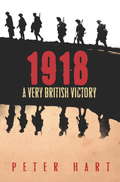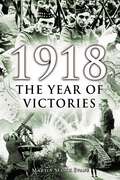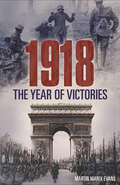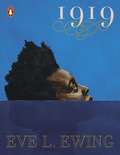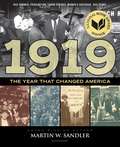- Table View
- List View
1916: A Global History
by Keith JefferyThe mud-filled, blood-soaked trenches of the Low Countries and North-Eastern Europe were essential battlegrounds during the First World War, but the war reached many other corners of the globe, and events elsewhere significantly affected its course. Covering the twelve months of 1916, eminent historian Keith Jeffery uses twelve moments from a range of locations and shows how they reverberated around the world. As well as discussing better-known battles such as Gallipoli, Verdun and the Somme, Jeffery examines Dublin, for the Easter Rising, East Africa, the Italian front, Central Asia and Russia, where the killing of Rasputin exposed the internal political weakness of the country's empire. And, in charting a wide range of wartime experience, he studies the 'intelligence war', naval engagements at Jutland and elsewhere, as well as the political consequences that ensued from the momentous US presidential election. Using an extraordinary range of military, social and cultural sources, and relating the individual experiences on the ground to wider developments, these are the stories lost to history, the conflicts that spread beyond the sphere of Europe and the moments that transformed the war.
1916: A Global History
by Keith JefferySo much of the literature on the First World War centers on the trench warfare of the Western Front, and these were essential battlegrounds. But the war was in fact truly a global conflict, and by focusing on a sequence of events in 1916 across many continents, historian Keith Jeffery's magisterial work casts new light on the Great War. Starting in January with the end of the catastrophic Gallipoli campaign, Jeffery recounts the massive struggle for Verdun over February and March; the Easter Rising in Ireland in April; dramatic events in Russia in June on the eastern front; the familiar story of the war in East Africa, where some 200,000 Africans may have died; and the November U.S. presidential race in which Woodrow Wilson was re-elected on a platform of keeping the United States out of the war--a position he reversed within five months.Incorporating the stories of civilians in all countries, both participants in and victims of the war, 1916: A Global History is a major addition to the literature and the Great War by a historian at the height of his powers.
1916 and All That: A History of Ireland From Back Then Until Right Now
by Ciara Boylan1916 and All That
The 1916 Diaries of an Irish Rebel and a British Soldier: of an Irish Rebel and a British Soldier
by Mick O'FarrellThis book contains the unpublished diaries of two men writing under fire on the streets of Dublin in April 1916. In Jacob’s factory, Volunteer Seosamh de Brún wrote in his tiny diary about guard duties and a bicycle sortie to help de Valera, during which a sniper killed one of the cyclists. Meanwhile, across the Liffey, British soldier Samuel Lomas wrote in his own diary of building barricades across Moore Street and participating in the executions of Pearse, Clarke and MacDonagh, giving new insights into the rebellion’s grim closing days. Mick O'Farrell brilliantly juxtaposes these two accounts, including fascimilies that show through deteriorating handwriting the increasing pressure the diarists were under, to give a dramatic account of how ordinary participants experienced the events of Easter week.
1916 in Global Context: An anti-Imperial moment (Routledge Studies in Modern European History)
by Enrico Dal Lago Róisín Healy Gearóid BarryThe year 1916 has recently been identified as "a tipping point for the intensification of protests, riots, uprisings and even revolutions." Many of these constituted a challenge to the international pre-war order of empires, and thus collectively represent a global anti-imperial moment, which was the revolutionary counterpart to the later diplomatic attempt to construct a new world order in the so-called Wilsonian moment. Chief among such events was the Easter Rising in Ireland, an occurrence that took on worldwide significance as a challenge to the established order. This is the first collection of specialist studies that aims at interpreting the global significance of the year 1916 in the decline of empires.
1916 in Global Context: An anti-Imperial moment (Routledge Studies in Modern European History)
by Enrico Dal Lago Róisín Healy Gearóid BarryThe year 1916 has recently been identified as "a tipping point for the intensification of protests, riots, uprisings and even revolutions." Many of these constituted a challenge to the international pre-war order of empires, and thus collectively represent a global anti-imperial moment, which was the revolutionary counterpart to the later diplomatic attempt to construct a new world order in the so-called Wilsonian moment. Chief among such events was the Easter Rising in Ireland, an occurrence that took on worldwide significance as a challenge to the established order. This is the first collection of specialist studies that aims at interpreting the global significance of the year 1916 in the decline of empires.
1916 - The Long Revolution: The Long Revolution
by Gabriel Doherty; Dermot KeoghIntroduction by Garret Fitzgerald. This book seeks to interpret the events of Easter Week 1916 as the central defining event of a 'long revolution' in Irish history. The origins of the long revolution lie in the second half of the nineteenth century, and its legacy is still being played out in the first years of the twenty-first century. Acknowledged experts on specific topics seek to explore the layered domestic and international, political, legal and moral aspects of this uniquely influential and controversial event. Contributors are: Rory O' Dwyer, Michael Wheatley, Brendan O'Shea and Gerry White, D.G. Boyce, Francis M. Carroll, Rosemary Cullen Owens, Jérôme aan de Wiel, Adrian Hardiman, Keith Jeffery, Mary McAleese, Owen McGee, Seamus Murphy and Brian P. Murphy.
The 1916 Preparedness Day Bombing: Anarchy and Terrorism in Progressive Era America (Critical Moments in American History)
by Jeffrey A. JohnsonThis book places the 1916 San Francisco Preparedness Day Bombing within the broader context of American radicalism and isolationism during the Progressive Era. A concise narrative and key primary documents offer readers an introduction to this episode of domestic violence and the subsequent, sensationalized trial that followed. The dubious conviction of a local labor organizer raised serious questions about political extremism, pluralistic ideals, and liberty in the United States that continue to resonate in the twenty-first century.
The 1916 Preparedness Day Bombing: Anarchy and Terrorism in Progressive Era America (Critical Moments in American History)
by Jeffrey A. JohnsonThis book places the 1916 San Francisco Preparedness Day Bombing within the broader context of American radicalism and isolationism during the Progressive Era. A concise narrative and key primary documents offer readers an introduction to this episode of domestic violence and the subsequent, sensationalized trial that followed. The dubious conviction of a local labor organizer raised serious questions about political extremism, pluralistic ideals, and liberty in the United States that continue to resonate in the twenty-first century.
The 1916 Proclamation: Ireland and the Easter Rising of 1916
by John O'ConnorOn Easter Monday, 24 April 1916, the tricolour flag was hoisted over the General Post Office. Shortly after noon Padraig Pearse, standing beneath the high portico, read the Proclamation publicly proclaiming Ireland a republic and a sovereign independent state. John O'Connor recounts the birth of this historic document which was to become one of the cornerstones of the new state. Why was it necessary? Who wrote it? Who secretly printed it and where? How was it distributed? How many exist? How would you know an authentic print? 'The Proclamation of the Irish Republic has been adduced in evidence against me as one of the signatories; you think it is already a dead and buried letter, but it lives, it lives. From minds alight with Ireland's vivid intellect it sprang; in hearts aflame with Ireland's mighty love it was conceived. Such documents do not die ... ' FROM THE COURT-MARTIAL SPEECH OF THOMAS MacDONAGH
1916 - What the People Saw
by Mick O'FarrellWhen the rebellion of 1916 had ended, more than 400 people were dead and over 2,000 wounded. More than half of these were civilians, but even for those civilians who were not direct casualties, the rising was one of the most momentous experiences of their lives. The accounts that Mick O'Farrell has collected come from letters, diaries, extracts from otherwise unrelated biographies, and contemporary magazine and newspaper articles. Some common themes are present in the accounts. For instance, a fear of going hungry, which resulted in constant, and dangerous, attempts to stock up with supplies. There was also a grim realisation (despite two years of World War) that war had arrived on their doorstep: ‘We know a bit what War is like now’. For some, there was even an undeniable element of excitement – one witness writes that ‘now that it’s over, none of us would’ve missed it for the world’. After watching a woman shot in the street, another witness notes that he ‘saw a man rush out and take a snapshot’. Elsewhere, there are ‘crowds looking on as if at a sham battle’. For most, however, it was the kind of excitement they could do without: Complementing the many historical accounts of the rising and statements from the participants, this book gives a real flavour of what it was like to live through history in the making.
1917: Key Dates and Events from the Fourth Year of the First World War
by Saul DavidThis special ebook has been created by historian Saul David from his acclaimed work 100 Days to Victory: How the Great War was Fought and Won, which was described by the Mail on Sunday as 'Inspired' and by Charles Spencer as 'A work of great originality and insight'. Through key dates from the abdication of Tsar Nicholas II, to the capture of Jerusalem, Saul David's gripping narrative is an enthralling tribute to a generation of men and women whose sacrifice should never be forgotten.
1917: War, Peace, and Revolution
by David Stevenson1917 was a year of calamitous events, and one of pivotal importance in the development of the First World War. In 1917: War, Peace, and Revolution, leading historian of World War One, David Stevenson, examines this crucial year in context and illuminates the century that followed. He shows how in this one year the war was transformed, but also what drove the conflict onwards and how it continued to escalate. Two developments in particular — the Russian Revolution and American intervention — had worldwide repercussions. Offering a close examination of the key decisions, David Stevenson considers Germany's campaign of 'unrestricted' submarine warfare, America's declaration of war in response, and Britain's frustration of German strategy by adopting the convoy system, as well as why (paradoxically) the military and political stalemate in Europe persisted. Focusing on the abdication of Tsar Nicholas II, on the disastrous spring offensive that plunged the French army into mutiny, on the summer attacks that undermined the moderate Provisional Government in Russia and exposed Italy to national humiliation at Caporetto, and on the British decision for the ill-fated Third Battle of Ypres (Passchendaele), 1917 offers a truly international understanding of events. The failed attempts to end the war by negotiation further clarify the underlying forces that kept it going. David Stevenson also analyses the global consequences of the year's developments, showing how countries such as Brazil and China joined the belligerents, Britain offered 'responsible government' to India, and the Allies promised a Jewish national home in Palestine. Blending political and military history, and moving from capital to capital and between the cabinet chamber and the battle front, the book highlights the often tumultuous debates through which leaders entered and escalated the war, and the paradox that continued fighting could be justified as the shortest road towards regaining peace.
1917: War, Peace, and Revolution
by David Stevenson1917 was a year of calamitous events, and one of pivotal importance in the development of the First World War. In 1917: War, Peace, and Revolution, leading historian of World War One, David Stevenson, examines this crucial year in context and illuminates the century that followed. He shows how in this one year the war was transformed, but also what drove the conflict onwards and how it continued to escalate. Two developments in particular — the Russian Revolution and American intervention — had worldwide repercussions. Offering a close examination of the key decisions, David Stevenson considers Germany's campaign of 'unrestricted' submarine warfare, America's declaration of war in response, and Britain's frustration of German strategy by adopting the convoy system, as well as why (paradoxically) the military and political stalemate in Europe persisted. Focusing on the abdication of Tsar Nicholas II, on the disastrous spring offensive that plunged the French army into mutiny, on the summer attacks that undermined the moderate Provisional Government in Russia and exposed Italy to national humiliation at Caporetto, and on the British decision for the ill-fated Third Battle of Ypres (Passchendaele), 1917 offers a truly international understanding of events. The failed attempts to end the war by negotiation further clarify the underlying forces that kept it going. David Stevenson also analyses the global consequences of the year's developments, showing how countries such as Brazil and China joined the belligerents, Britain offered 'responsible government' to India, and the Allies promised a Jewish national home in Palestine. Blending political and military history, and moving from capital to capital and between the cabinet chamber and the battle front, the book highlights the often tumultuous debates through which leaders entered and escalated the war, and the paradox that continued fighting could be justified as the shortest road towards regaining peace.
1917 and the Consequences (Routledge Studies in Modern History)
by Gerhard Besier Katarzyna Stok 322 OsaThe Russian Revolution of 1917 has been one of the most important events of modern history. It changed the course of the events not only in Russia but, on a wider scale, across the world while it influenced the flow of history throughout the twentieth century until the fall of the Soviet Union and, to some extent, well beyond this time. Radical change in Russia triggered social revolutions and reformations across Europe, while authoritarian systems shaped their societies according to the Russian model. This book analyses these forces, particularly at the European periphery which has been underexplored until this volume.
1917 and the Consequences (Routledge Studies in Modern History)
by Gerhard Besier Katarzyna Stok 322 OsaThe Russian Revolution of 1917 has been one of the most important events of modern history. It changed the course of the events not only in Russia but, on a wider scale, across the world while it influenced the flow of history throughout the twentieth century until the fall of the Soviet Union and, to some extent, well beyond this time. Radical change in Russia triggered social revolutions and reformations across Europe, while authoritarian systems shaped their societies according to the Russian model. This book analyses these forces, particularly at the European periphery which has been underexplored until this volume.
1918: Winning the War, Losing the War (Cambridge Military Histories Ser.)
by Nicholas Carter Matthias Strohn James S. Corum Maj Gen Mungo Melvin CB OBE David T. Zabecki David Murphy Jonathan Boff Mitch Yockelson Lothar Höbelt Dr Robert Johnson Michael EpkenhansIn 2018, the world will be commemorating the centenary of the end of the First World War. In many ways, 1918 was the most dramatic year of the conflict. After the defeat of Russia in 1917, the Germans were able to concentrate their forces on the Western Front for the first time in the war, and the German offensives launched from March 1918 onward brought the Western Allies close to defeat. Having stopped the German offensives, the Entente started its counter-attacks on all fronts with the assistance of fresh US troops, driving the Germans back and, by November 1918, the Central Powers had been defeated. This new study is a multi-author work containing ten chapters by some of the best historians of the First World War from around the world writing today. It provides an overview and analysis of the different levels of war for each of the main armies involved within the changing context of the reality of warfare in 1918. It also looks in detail at the war at sea and in the air, and considers the aftermath and legacy of the First World War.
1918: Winning the War, Losing the War
by Nicholas Carter Matthias Strohn James S. Corum Mungo Melvin CB OBE David T. Zabecki David Murphy Jonathan Boff Mitch Yockelson Lothar Höbelt Robert Johnson Michael EpkenhansIn 2018, the world will be commemorating the centenary of the end of the First World War. In many ways, 1918 was the most dramatic year of the conflict. After the defeat of Russia in 1917, the Germans were able to concentrate their forces on the Western Front for the first time in the war, and the German offensives launched from March 1918 onward brought the Western Allies close to defeat. Having stopped the German offensives, the Entente started its counter-attacks on all fronts with the assistance of fresh US troops, driving the Germans back and, by November 1918, the Central Powers had been defeated. This new study is a multi-author work containing ten chapters by some of the best historians of the First World War from around the world writing today. It provides an overview and analysis of the different levels of war for each of the main armies involved within the changing context of the reality of warfare in 1918. It also looks in detail at the war at sea and in the air, and considers the aftermath and legacy of the First World War.
1918: War and Peace
by Gregor DallasOn the night of 7 November 1918 French troops at La Capelle, on the Western Front, noticed a soft halo develop in the fog over no man's land. They heard the rumble of cars, then perceived the vague form of a huge white flag: the Germans were crossing the line to seek peace. But who were these Germans and what exactly did they represent? By the time they had signed an armistice, four days later, not even they knew. The Kaiser's Reich had collapsed and Germany faced chaos, while the war in Eastern Europe continued. This book traces the transition from war to peace across Europe. It follows the movement of armies over the northern plains, their collapse, their demoblization, and the effect this had on the material life of people. In Russia there had already been a revolution. In Germany, there were attempts to overthrow the provisional republican government. In Poland new wars broke out. At the same time, there was celebration in the West at the announcement of the Armistice. And the United States entered European politics with a new part to play. Dallas follows these dramatic events from the perspective of five capitals: Berlin, Paris, London, Moscow and Washington. In Berlin the cabarets and beer halls are open, while there is shooting in the streets. In the walled city of Paris, the peacemakers assemble to respond to the call for a League of Nations. Pantomime season opens in London, where Lloyd George holds elections and reorganizes his War Cabinet; John Maynard Keynes of the Treasury worries about debts. Contemporaries describe Moscow as a scene of desolation; but Lenin insists on setting up the Third International. Washington is divided between those who want to open America to the world, and those who would prefer the world to go away. The start of peace is more complex and fascinating than the start of war; it sets the habits and builds the patterns of life for generations to come. This book weaves politics, ideas, social life, fears, aspirations and harsh realities into a seamless reconstruction of life experienced at a great turning-point of history.
1918: A Very British Victory
by Peter HartThe story of the huge mobile battles of 1918, which finally ended the Great War. 1918 was the critical year of battle as the Great War reached its brutal climax. Warfare of an epic scale was fought on the Western Front, where ordinary British soldiers faced the final test of their training, tactics and determination. That they withstood the storm and began an astonishing counterattack, is proof that by 1918, the British army was the most effective fighting force in the world. But this ultimate victory came at devastating cost. Using a wealth of previously unpublished material, historian Peter Hart gives a vivid account of this last year of conflict - what it was like to fight on the frontline, through the words of the men who were there. In a chronicle of unparalleled scope and depth, he brings to life the suspense, turmoil and tragedy of 1918's vast offensives.
1918: The Year of Victories
by Martin Marix EvansAt the outset of 1918 Germany faced certain defeat as a result of Allied technical innovation in tanks and aircraft, and the American entry into the war. Victory could only be gained by the immediate application of overwhelming force in new tactical form; the 'fire-waltz' artillery barrage and the storm-trooper infantry attack.1918 examines both the Germans' tactics and the Allies' preferred solution to fighting this war, the combination of artillery, tanks, infantry and aircraft, and argues that this reached a level of sophistication in command and control never before achieved.The war of attrition was far from over, but as more Americans arrived in France the ghastly cost became affordable. For the Germans, it became a question of whether they could negotiate an armistice before their armies were utterly destroyed.
1918: The Year of Victories
by Martin Marix EvansAt the outset of 1918 Germany faced certain defeat as a result of Allied technical innovation in tanks and aircraft, and the American entry into the war. Victory could only be gained by the immediate application of overwhelming force in new tactical form; the 'fire-waltz' artillery barrage and the storm-trooper infantry attack. 1918 examines both the Germans' tactics and the Allies' preferred solution to fighting this war, the combination of artillery, tanks, infantry and aircraft, and argues that this reached a level of sophistication in command and control never before achieved. The war of attrition was far from over, but as more Americans arrived in France the ghastly cost became affordable. For the Germans, it became a question of whether they could negotiate an armistice before their armies were utterly destroyed.
1919
by Eve EwingIn 1919, award-winning poet Eve L. Ewing recovers the essentially human stories at the heart of the Chicago Race Riot of 1919: of the people who took part in it, and of the lives that were marked by it.This most intense of the riots of the USA's 'Red Summer' lasted eight days, resulting in thirty-eight deaths and almost 500 injuries; it was a signal and traumatic event which has now shaped the history of the city where it took place for a century. As well as telling the tale of the riot itself and the cruel murder which precipitated it, the poems of 1919 explore its aftermath and bring to vivid life the mass migrations which had set the stage for this violence in the preceding years.Poetically recounting the stories of everyday people trying to survive and thrive in the city, and using speculative and Afrofuturist lenses to reimagine history, the result is a book which unearths the universal at the heart of the particular, and illuminates the fine line between past and present.
1919 The Year That Changed America
by Martin W. SandlerA National Book Award finalist1919 was a world-shaking year. America was recovering from World War I and black soldiers returned to racism so violent that that summer would become known as the Red Summer. The suffrage movement had a long-fought win when women gained the right to vote. Laborers took to the streets to protest working conditions; nationalistic fervor led to a communism scare; and temperance gained such traction that prohibition went into effect. Each of these movements reached a tipping point that year. Now, one hundred years later, these same social issues are more relevant than ever. Sandler traces the momentum and setbacks of these movements through this last century, showing that progress isn't always a straight line and offering a unique lens through which we can understand history and the change many still seek.
1919 The Year That Changed America
by Martin W. SandlerA National Book Award finalist1919 was a world-shaking year. America was recovering from World War I and black soldiers returned to racism so violent that that summer would become known as the Red Summer. The suffrage movement had a long-fought win when women gained the right to vote. Laborers took to the streets to protest working conditions; nationalistic fervor led to a communism scare; and temperance gained such traction that prohibition went into effect. Each of these movements reached a tipping point that year. Now, one hundred years later, these same social issues are more relevant than ever. Sandler traces the momentum and setbacks of these movements through this last century, showing that progress isn't always a straight line and offering a unique lens through which we can understand history and the change many still seek.
